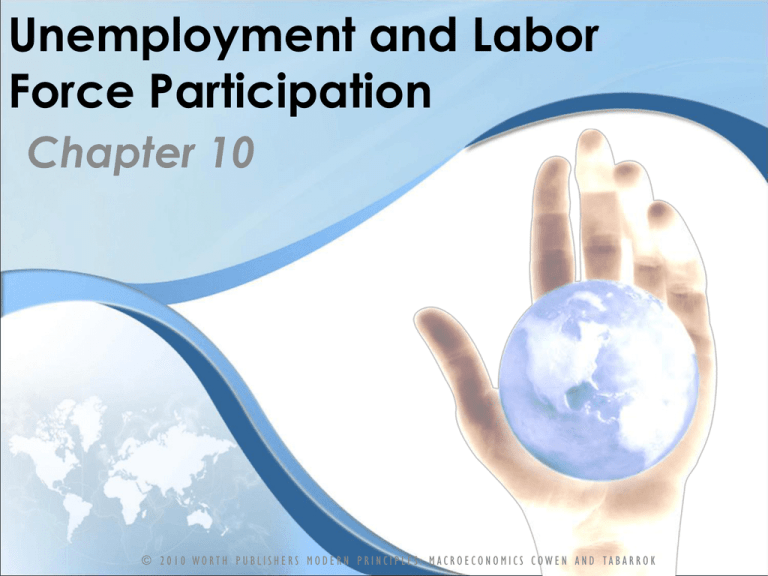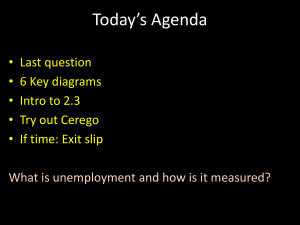
Unemployment and Labor
Force Participation
Chapter 10
© 2010 WORTH PUBLISHERS MODERN PRINCIPLES: MACROECONOMICS COWEN AND TABARROK
Introduction
• A Recurring Story in American History
– Many jobs have disappeared- and been
replaced by new jobs….
Chapter Outline
•
•
•
•
•
•
•
Defining Unemployment
Frictional Unemployment
Structural Unemployment
Cyclical Unemployment
Labor Force Participation
Takeaway
See the Invisible Hand Blog (click) for more
examples
Click here for the current
U.S. unemployment rate
Defining Unemployment
• Measuring Unemployment
– A person is counted as unemployed if they…
•
•
•
•
Are 16 years of age or older.
Are not institutionalized (e.g., not in prison).
Are not in the military.
Are looking for work.
– The unemployment rate is the % of the labor
force without a job
Unemployed
100
Unemployed Employed
Unemployed
100
Labor force
Unemployment rate (%)
Defining Unemployment
• Unemployed worker: an adult who does
not have a job but is looking for work.
• Labor force: all workers, employed plus
unemployed
• Labor force participation rate: the
percentage of adults in the labor force
Try it!
In your country, there are 24 million
people in the labor force. 21.5 million
people are employed. What is the
unemployment rate in your country?
a)
b)
c)
d)
10.4%
2.5%
89.6%
21.5%
7
Try it!
In your country, there are 24 million
people in the labor force. 21.5 million
people are employed. What is the
unemployment rate in your country?
a)
b)
c)
d)
10.4%
2.5%
89.6%
21.5%
8
Defining Unemployment
• How Good an Indicator Is the Unemployment
Rate?
– Does not account for discouraged workers.
• discouraged workers : workers that have
given up looking for work who would still like
to have a job.
• account for 0.3% of the labor force.
• For long recessions the number of
discouraged workers will be higher.
– Implication: In recessions that last a long time, the
unemployment rate is not as good an indicator.
Defining Unemployment
• How Good an Indicator Is the Unemployment
Rate?
– Doesn’t measure the quality of jobs or how well
people are matched to their jobs.
• Examples:
– An overqualified worker, or one with a parttime job (who wants to work full-time) is
counted as fully employed.
– Economists also look at other indicators:
• Labor force participation rate
• Number of full-time jobs
• Average wages
Defining Unemployment
• There are three types of unemployment:
– Frictional
– Structural
– Cyclical
Frictional Unemployment
• Frictional unemployment: Short-term
unemployment caused by difficulties of
matching employee to employer.
– Scarcity of information creates frictional
unemployment.
• Matching people to jobs takes time….
Frictional Unemployment
• Usually doesn’t last very long.
– 2005: 35% of unemployment lasted less than 5
weeks.
• Is a large share of total unemployment
because:
– the U.S. economy is dynamic.
• “Creative Destruction”-Joseph Schumpeter.
– progress is about creating new jobs and destroying old
jobs.
– it takes time to adjust to innovation and the job
creation/destruction that ensues:
Structural Unemployment
• Structural Unemployment: Persistent, long-term
unemployment caused by long-lasting shocks
or permanent changes in the economy.
– Causes:
• Large shocks that take a long time for the
economy to restructure.
– Oil shocks: fuel alternatives take time to create.
– New information technologies: create new
industries and cause the disappearance of
others.
– Globalization: decline of manufacturing and
the rise of the service economy.
Structural Unemployment
• Structural unemployment, if it lasts long
enough, brings significant human costs.
– At some point unemployment can become
chronic.
• The longer a worker is out of work, his or her
skills atrophy.
• Hiring managers are wary of hiring workers
who have been unemployed for a long time.
– Who would you rather hire: a worker looking
to switch jobs or a worker who has been
unemployed for five years?
• Result: Unemployment can become a trap.
Duration of U.S. Unemployment
Most unemployment is short duration
Structural Unemployment
Labor Regulations and Structural Unemployment
– In the U.S. unemployment increases with a shock,
then declines.
– In Europe unemployment has increased with
shocks but has not declined.
Structural Unemployment
•
Unemployment rates in the U.S. and
Europe differ because of differences in
labor regulations.
1. Unemployment benefits are more generous in
Europe.
2. Unemployment benefits last longer in Europe.
3. Minimum wages are higher in Europe and
unions are stronger.
•
•
The higher the minimum wage is above the market
wage, the greater unemployment will be.
Unions have the same effect.
Structural Unemployment
Structural Unemployment
• Union: an association of workers that
bargains collectively with employers over
wages, benefits, and working conditions.
– Unions take many forms: some act to increase
wages simply by restricting entry into a
profession with licensing requirements.
Structural Unemployment
• Median Wage: the wage such that ½ of all
workers earn wages below the median and
½ of all workers earn wages above the
median.
– Minimum wages in Europe are higher than the
U.S. (France= 40% higher)
– European minimum wages are also higher
relative to their median wage than the U.S.
– Result: minimum wage creates more
unemployment in Europe than it does in the U.S.
– Minimum wage in Europe affects more workers than
U.S. minimum wage does.
Structural Unemployment
Effect of Minimum Wage on Unemployment
Supply of Labor
Wage
Unemployment
Minimum
wage
Market
wage
Result:
Minimum wage causes
unemployment
Demand
for labor
Employment
Labor supplied
Market
with minimum
with minimum
employment
wage
wage
Quantity
Of Labor
Structural Unemployment
Potential Effect of Unions on Unemployment
Supply of Labor
Wage
Unemployment
Union
wage
Result:
Certain types of unions
can cause
unemployment
Market
wage
Demand
for labor
Employment
with Union
Labor supplied
Market
with union wage
employment
Quantity
Of Labor
Structural Unemployment
Employment Protection Laws
•
The U.S. uses the employment at-will doctrine.
• employment at-will doctrine: an employee
may quit and an employer may fire for any
reason.
• many exceptions: race, religion, sex, sexual
orientation, national origin, age, or handicap
status.
• most basic U.S. employment law.
Structural Unemployment
•
World Bank “rigidity of employment index”
• summarizes hiring and firing costs
• the higher the index, the greater the costs
SEE THE INVISIBLE HAND
Can you spot the differences?
Unemployed teens (outsiders) want France to adopt At-Will employment
to make it easier for firms to hire, and riot in 2005.
Then France proposed the changes, and employed teens (insiders) rioted
against the changes in 2006.
France capitulated.
Bottom line: it’s not easy to change employment law.
26
Structural Unemployment
• In summary, European labor regulations:
• create valuable insurance for workers
with a full-time job.
• make labor markets less flexible and
dynamic.
• increase the duration of unemployment.
• increase unemployment rates among
young, minority, or otherwise “riskier”
workers.
Is miminum wage a force for
good or a force for bad? Yes.
Structural Unemployment
Labor Regulations to Reduce Structural
Unemployment
– Europe has begun to change its labor laws.
• Reducing unemployment benefits
• Adopting active labor market policies: work
tests, job search assistance and job retraining
programs focus on getting unemployed
workers back to work.
• Allowing exceptions to collective bargaining
agreements.
Structural Unemployment
Factors that Affect Structural Unemployment
– Large, long-lasting shocks like:
•
•
•
•
Oil shocks
Shift from manufacturing to services
Globalization and global competition
Fundamental technology (computers/Internet)
– Labor regulations
•
•
•
•
Unemployment benefits
Minimum wages
Powerful unions
Employment protection laws
Cyclical Unemployment
Cyclical Unemployment: unemployment
correlated with the business cycle
• Lower growth is usually correlated with
higher unemployment for two reasons:
1. When GDP falls, firms lay off workers.
2. Idle labor and capital → economic growth is
not being maximized → ↓ ability of the
economy to create more jobs.
Cyclical Unemployment
Unemployment increases during a recession
Cyclical Unemployment
Faster growth in Real GDP decreases unemployment
Cyclical Unemployment
What causes cyclical unemployment?
– Non “Keynesians”: Caused by real shocks
that require a reallocation of resources.
• Cyclical unemployment is just another
example of frictional and structural
unemployment.
– “Keynesians”: Caused by deficiencies in
aggregate demand.
• For now: consider it a mismatch between the
aggregate level of wages and the level of
prices.
Cyclical Unemployment
• The Natural Unemployment Rate: Structural
plus frictional unemployment.
Note: Total unemployment changes much quicker than the natural unemployment rate.
Labor Force Participation
Measuring the labor force participation rate
– The % of the adult (16+) non-institutionalized
civilian population who are working or actively
looking for work.
Labor Force Unemployed Employed 100
Adult population
Participation
Rate
Labor force
100
Adult population
Example, U.S. 2009:
Labor Force
Participation
Rate
154 .04 million
100 65 .5%
235 .09 million
Labor Force Participation
What determines the labor force participation
rate?
1. Lifecycle Effects and Demographics
Baby Boomers: people born during the high birthrate years, 1946-1964
Implication: As the U.S. labor force ages, the participation rate will fall
Labor Force Participation
Labor force participation varies significantly across countries.
Males, age 55-64, 1998 data from OECD Statistics
Labor Force Participation
2. Differences in Incentives
– Taxes and Benefits
• Taxes discourage work and benefits
encourage non-work.
– Many countries penalize workers who work past
the normal early retirement age.
» Netherlands in the 1990s: Working past the
age of 60 meant losing one year of
government retirement benefits.
» Result: Individual working past age 60 after
paying payroll taxes made less money than a
worker who retired.
Labor Force Participation
Labor force participation declines with higher taxes.
Males, age 55-64, 2005 data from OECD Statistics
Labor Force Participation
2. Differences in Incentives
– Incentives and the rise in female labor force
participation:
• 1948 -2008: number of women aged 25-54 in the paid
labor force increased from 35% to 75%.
• What caused this?
– Cultural factors
» Rise of feminism
» Growing acceptance of equality
– Move from a manufacturing to a service
economy.
Female Labor Force
Participation
Female Labor Force
Participation, Professions
Labor Force Participation
• Differences in Incentives
– How “the pill” increased female labor force
participation:
• lowered the:
– cost of earning a professional degree.
– uncertainty about the consequences of sex.
• Result: the pill lowered the costs and increased the
incentive of women to invest in a long-term education.
Key Concepts
Unemployed
Labor Force
Unemployment Rate
Labor Force
Participation Rate
• Discouraged workers
• Frictional
Unemployment
• Structural
Unemployment
•
•
•
•
• Median Wage
• Union
• Employment At-Will
Doctrine
• Active Labor market
Policies
• Cyclical
Unemployment
• Natural Unemployment
• Rate Baby Boomers
Try it!
Which of the following individuals can
be counted as unemployed?
a) Darren, a ten-year-old child
b) Nazma, a stay-at-home mom
c) Moesha, a full-time college student
d) None of the answers is correct.
45
Try it!
Which of the following individuals can
be counted as unemployed?
a) Darren, a ten-year-old child
b) Nazma, a stay-at-home mom
c) Moesha, a full-time college student
d) None of the answers is correct.
46
Try it!
Adult population
200 million
Labor force
150 million
Employed persons
138.75 million
Discouraged workers
10.5 million
According to the accompanying labor data, the
unemployment rate is _________ and the labor
force participation rate is __________.
a) 7%; 60.4%
b) 0.7%; 99.3%
c) 5.6%; 69.4%
d) 7.5%; 75%
47
Try it!
Adult population
200 million
Labor force
150 million
Employed persons
138.75 million
Discouraged workers
10.5 million
According to the accompanying labor data, the
unemployment rate is _________ and the labor
force participation rate is __________.
a) 7%; 60.4%
b) 0.7%; 99.3%
c) 5.6%; 69.4%
d) 7.5%; 75%
48
Try it!
According to the Bureau of Labor Statistics,
unemployment includes :
I. discouraged workers.
II. workers who are overqualified for their
work.
III. workers who have a part-time job but want
a full-time job.
a)
b)
c)
d)
I and II only
II and III only
I, II, and III only
None of the answers are correct.
49
Try it!
According to the Bureau of Labor Statistics,
unemployment includes :
I. discouraged workers.
II. workers who are overqualified for their
work.
III. workers who have a part-time job but want
a full-time job.
a)
b)
c)
d)
I and II only
II and III only
I, II, and III only
None of the answers are correct.
50
Try it!
Jasmine has recently moved to Florida
because she loves the warm climate there.
Because she is new to the area, she will need
to spend a few weeks looking for a new job.
This is an example of:
a) frictional unemployment.
b) cyclical unemployment.
c) structural unemployment.
d) underemployment.
51
Try it!
Jasmine has recently moved to Florida
because she loves the warm climate there.
Because she is new to the area, she will need
to spend a few weeks looking for a new job.
This is an example of:
a) frictional unemployment.
b) cyclical unemployment.
c) structural unemployment.
d) underemployment.
52









